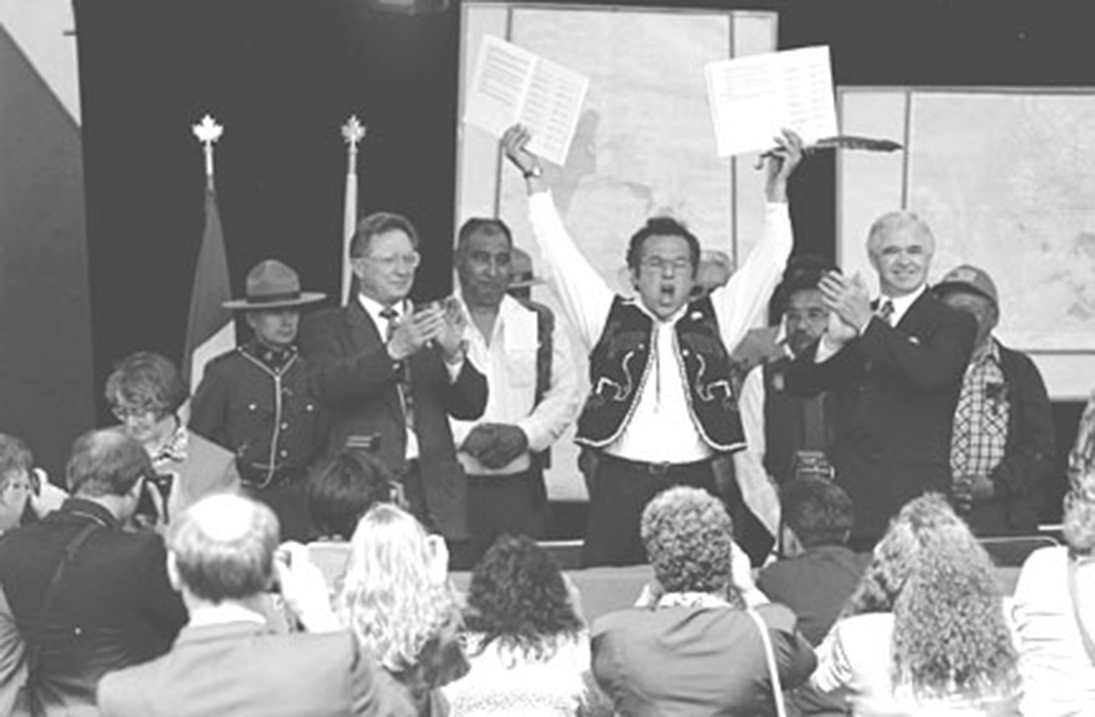200-Plus Attend Historic Land Claim Signing
Indian Affairs Minister Tom Siddon's signing of a Yukon land claim settlement on Saturday was described by onlookers at the three-hour ceremony as the cornerstone for the future for Yukon Indians.
By Whitehorse Star on May 31, 1993
Indian Affairs Minister Tom Siddon's signing of a Yukon land claim settlement on Saturday was described by onlookers at the three-hour ceremony as the cornerstone for the future for Yukon Indians.
"These are historic agreements - modern day treaties that acknowledge that Indians occupied this part of Canada long before European settlers arrived," Siddon told more that 200 people who gathered for the outdoor ceremony.
"Once they are proclaimed, these final land claims agreements will be given constitutional protection. The beneficiaries will lay to rest the question of land ownership that has created uncertainty, argumentation and litigation for so many years."
Yukon Indians have long argued that the Government of Canada never fulfilled a legal obligation according to its own laws to sign treaties with Yukon First Nations before settling here.
Siddon, Council for Yukon Indians' chair Judy Gingell and Government Leader John Ostashek took turns signing the Umbrella Final Agreement.
It sets out general settlement provisions, such as the overall amount of land Yukon Indians will retain, and forms the basis under which the 14 First Nations will negotiate their individual land claim agreements.
The minister and government leader also signed First Nation final agreements and self-government agreements with Champagne-Aishihik Chief Paul Birckel, Nikko Nyak Dun Chief Robert Hager, Teslin Tlingit Chief Dave Keenan and Vuntut Gwich'in Chief Robert Bruce Jr. Each of the First Nations received a $1-million signing bonus from the federal government, to be subtracted from their overall settlement amounts.
The four First Nations were given the go-ahead some two years ago by the other 10 First Nations to forge the way. The other 10 still have to negotiate their final agreements.
Led by drummer Jerry Alfred, Siddon, Gingell, and Ostashek, the four chiefs walked from the Yukon Indian Centre across Nisutlin Drive to a large grassy area and onto a stage set under a concert-type tent.
The atmosphere was electric. Many watching the historic event mentioned how it was hard to believe that after 20 years of negotiations, agreements were actually being signed.
The event was telecast live by Television Northern Canada and broadcast by CBC radio.
Dozens of professional and amateur photographers recorded the moments.
Following the official ceremony, a buffet lunch was served as people mingled and congratulated one another and collected signatures on their invitations from anyone and everyone.
"There is no doubt the signing of First Nation Final Agreements will change for the better the relationship between the First Nations and other Governments," Gingell said in her address.
"We will look to our agreements to establish and maintain the partnership and cooperation we deserve as self-governing citizens in our homeland.
Siddon said that by establishing the certainty over land ownership and resource management, "these agreements will provide a positive, harmonious and secure climate for business."
The certainty will attract new investment and new jobs that will mean self-reliance and self-esteem for Yukon Indians, the minister said.
The only obstacle remaining, however, is approval of the settlement by the House of
Commons. Siddon said he couldn't give any guarantees it would be approved before the House breaks for the summer next month.
After 20 years, Yukon Indians are nervously afraid that if the agreement doesn't get passed during this sitting, it will be buried at the 11th-hour by the frenzy of the pending federal election, to surface only when the next federal government is ready to deal with it.
Under the settlement, the Yukon's 14 First Nations, representing some 8,000 beneficiaries, will divide amongst themselves $280 million and 41,400 square kilometres, or 8.6 per cent of the total Yukon land mass.
The Umbrella Final Agreement establishes a cooperative management system between the First Nations and the territorial government for wild life, land use and other territorial wide matters.
The settlement also provides for Indian self-government, including the eventual ability for First Nation to raise revenue through taxation on its membership.
Without exception, Siddon Ostashek, Gingell and each of the chiefs paid tribute to the late elder Elijah Smith, who died in October 1991, in a Robert Campbell Highway traffic accident.
Smith headed the Yukon Indian delegation to Ottawa in 1973 to present to then-prime minister Pierre Trudeau the document that formed the basis of the Yukon land claim - Today for Our Children Tomorrow.
It was Smith's photo that was featured in the invitation to the signing ceremony.
"Today's events are the culmination of 20 years of hard work, dedication and sacrifice by many First Nations' people," Gingell said.
"At a time like this, it is impossible not to think of Elijah smith, and wish he were here to witness the results of the leadership he provided for so many years.
"Of course, Elijah would have been the first to say that there were great many other First Nation leaders who worked to make today's events possible.
Chuck Tobin, Star Reporter
For more Yukon history, purchase the three editions of history totalling over 300 pages and covering 100 years of stories reported in the Whitehorse Star from 1900 up to 2000.
$3.00 per copy (shipping not included)
To order e-mail: circulation@whitehorsestar.com

Be the first to comment